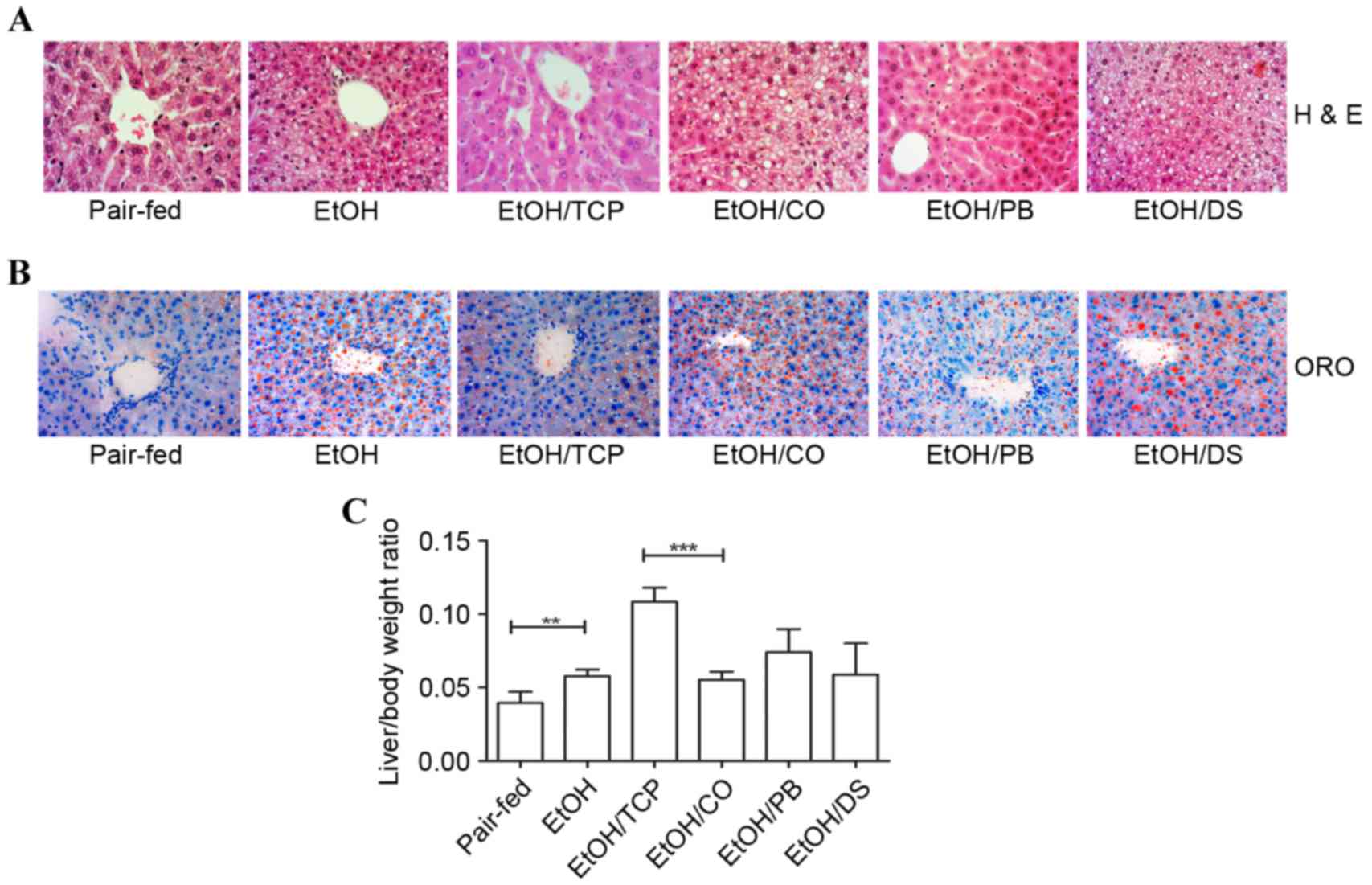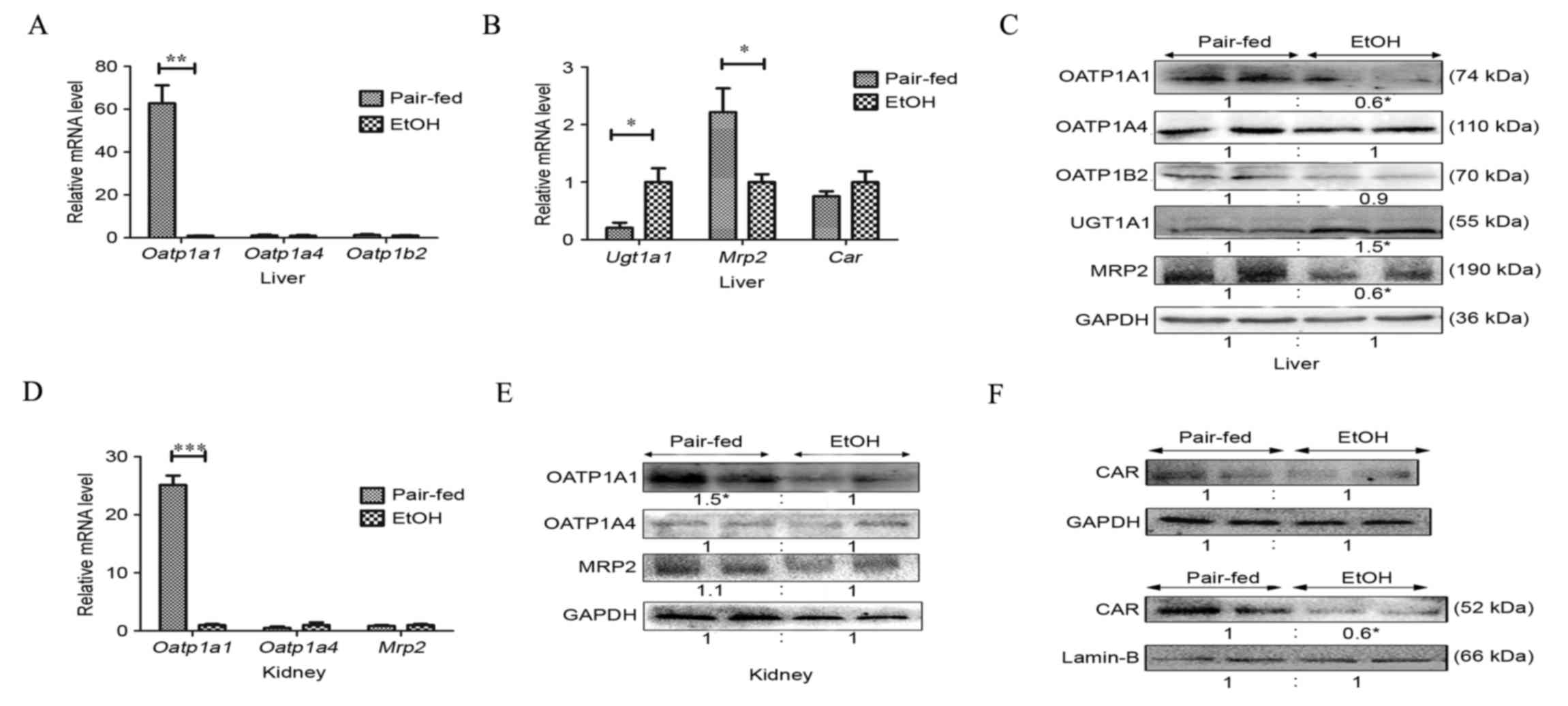|
1
|
Orman ES, Odena G and Bataller R:
Alcoholic liver disease: Pathogenesis, management, and novel
targets for therapy. J Gastroenterol Hepatol. 28 Suppl 1:S77–S84.
2013. View Article : Google Scholar
|
|
2
|
Chalmers DM, Rinsler MG, MacDermott S,
Spicer CC and Levi AJ: Biochemical and haematological indicators of
excessive alcohol consumption. Gut. 22:992–996. 1981. View Article : Google Scholar : PubMed/NCBI
|
|
3
|
Torkadi PP, Apte IC and Bhute AK:
Biochemical evaluation of patients of alcoholic liver disease and
non-alcoholic liver disease. Indian J Clin Biochem. 29:79–83. 2014.
View Article : Google Scholar : PubMed/NCBI
|
|
4
|
Zollner G, Fickert P, Zenz R, Fuchsbichler
A, Stumptner C, Kenner L, Ferenci P, Stauber RE, Krejs GJ, Denk H,
et al: Hepatobiliary transporter expression in percutaneous liver
biopsies of patients with cholestatic liver diseases. Hepatology.
33:633–646. 2001. View Article : Google Scholar : PubMed/NCBI
|
|
5
|
Kardon T, Coffey MJ, Bánhegyi G, Conley
AA, Burchell B, Mandl J and Braun L: Transcriptional induction of
bilirubin UDP-glucuronosyltransrase by ethanol in rat liver.
Alcohol. 21:251–257. 2000. View Article : Google Scholar : PubMed/NCBI
|
|
6
|
Flitman R and Worth MH Jr: Inhibition of
hepatic alcohol dehydrogenase by bilirubin. J Biol Chem.
241:669–672. 1966.PubMed/NCBI
|
|
7
|
Bodeman CE, Dzierlenga AL, Tally CM,
Mulligan RM, Lake AD, Cherrington NJ and McKarns SC: Differential
regulation of hepatic organic cation transporter 1, organic
anion-transporting polypeptide 1a4, bile-salt export pump and
multidrug resistance-associated protein 2 transporter expression in
lymphocyte-deficient mice associates with interleukin-6 production.
J Pharmacol Exp Ther. 347:136–144. 2013. View Article : Google Scholar : PubMed/NCBI
|
|
8
|
Keppler D: The roles of MRP2, MRP3,
OATP1B1, and OATP1B3 in conjugated hyperbilirubinemia. Drug Metab
Dispos. 42:561–565. 2014. View Article : Google Scholar : PubMed/NCBI
|
|
9
|
Erlinger S, Arias IM and Dhumeaux D:
Inherited disorders of bilirubin transport and conjugation: New
insights into molecular mechanisms and consequences.
Gastroenterology. 146:1625–1638. 2014. View Article : Google Scholar : PubMed/NCBI
|
|
10
|
Iusuf D, van de Steeg E and Schinkel AH:
Functions of OATP1A and 1B transporters in vivo: Insights from
mouse models. Trends Pharmacol Sci. 33:100–108. 2012. View Article : Google Scholar : PubMed/NCBI
|
|
11
|
Wagner M, Halilbasic E, Marschall HU,
Zollner G, Fickert P, Langner C, Zatloukal K, Denk H and Trauner M:
CAR and PXR agonists stimulate hepatic bile acid and bilirubin
detoxification and elimination pathways in mice. Hepatology.
42:420–430. 2005. View Article : Google Scholar : PubMed/NCBI
|
|
12
|
Yang H, Plösch T, Lisman T, Gouw AS, Porte
RJ, Verkade HJ and Hulscher JB: Inflammation mediated
down-regulation of hepatobiliary transporters contributes to
intrahepatic cholestasis and liver damage in murine biliary
atresia. Pediatr Res. 66:380–385. 2009. View Article : Google Scholar : PubMed/NCBI
|
|
13
|
Yang H and Wang H: Signaling control of
the constitutive androstane receptor (CAR). Protein Cell.
5:113–123. 2014. View Article : Google Scholar : PubMed/NCBI
|
|
14
|
Tojima H, Kakizaki S, Yamazaki Y, Takizawa
D, Horiguchi N, Sato K and Mori M: Ligand dependent hepatic gene
expression profiles of nuclear receptors CAR and PXR. Toxicol Lett.
212:288–297. 2012. View Article : Google Scholar : PubMed/NCBI
|
|
15
|
Luisier R, Lempiäinen H, Scherbichler N,
Braeuning A, Geissler M, Dubost V, Müller A, Scheer N, Chibout SD,
Hara H, et al: Phenobarbital Induces cell cycle transcriptional
responses in mouse liver humanized for constitutive androstane and
pregnane X receptors. Toxicol Sci. 139:501–511. 2014. View Article : Google Scholar : PubMed/NCBI
|
|
16
|
Assenat E, Gerbal-Chaloin S, Larrey D,
Saric J, Fabre JM, Maurel P, Vilarem MJ and Pascussi JM:
Interleukin 1beta inhibits CAR-induced expression of hepatic genes
involved in drug and bilirubin clearance. Hepatology. 40:951–960.
2004. View Article : Google Scholar : PubMed/NCBI
|
|
17
|
Petrick JS and Klaassen CD: Importance of
hepatic induction of constitutive androstane receptor and other
transcription factors that regulate xenobiotic metabolism and
transport. Drug Metab Dispos. 35:1806–1815. 2007. View Article : Google Scholar : PubMed/NCBI
|
|
18
|
Saini SP, Mu Y, Gong H, Toma D, Uppal H,
Ren S, Li S, Poloyac SM and Xie W: Dual role of orphan nuclear
receptor pregnane X receptor in bilirubin detoxification in mice.
Hepatology. 41:497–505. 2005. View Article : Google Scholar : PubMed/NCBI
|
|
19
|
Chen X, Meng Z, Wang X, Zeng S and Huang
W: The nuclear receptor CAR modulates alcohol-induced liver injury.
Lab Invest. 91:1136–1145. 2011. View Article : Google Scholar : PubMed/NCBI
|
|
20
|
Wu W, Zhu B, Peng X, Zhou M, Jia D and Gu
J: Activation of farnesoid X receptor attenuates hepatic injury in
a murine model of alcoholic liver disease. Biochem Biophys Res
Commun. 443:68–73. 2014. View Article : Google Scholar : PubMed/NCBI
|
|
21
|
Fisher CD, Lickteig AJ, Augustine LM,
Elferink RP Oude, Besselsen DG, Erickson RP and Cherrington NJ:
Experimental non-alcoholic fatty liver disease results in decreased
hepatic uptake transporter expression and function in rats. Eur J
Pharmacol. 613:119–127. 2009. View Article : Google Scholar : PubMed/NCBI
|
|
22
|
Zinchuk V, Zinchuk O, Akimaru K, Moriya F
and Okada T: Ethanol consumption alters expression and
colocalization of bile salt export pump and multidrug resistance
protein 2 in the rat. Histochem Cell Biol. 127:503–512. 2007.
View Article : Google Scholar : PubMed/NCBI
|
|
23
|
Lee J, Azzaroli F, Wang L, Soroka CJ,
Gigliozzi A, Setchell KD, Kramer W and Boyer JL: Adaptive
regulation of bile salt transporters in kidney and liver in
obstructive cholestasis in the rat. Gastroenterology.
121:1473–1484. 2001. View Article : Google Scholar : PubMed/NCBI
|
|
24
|
Masereeuw R and Russel FG: Regulatory
pathways for ATP-binding cassette transport proteins in kidney
proximal tubules. AAPS J. 14:883–894. 2012. View Article : Google Scholar : PubMed/NCBI
|
|
25
|
Geier A, Wagner M, Dietrich CG and Trauner
M: Principles of hepatic organic anion transporter regulation
during cholestasis, inflammation and liver regeneration. Biochim
Biophys Acta. 1773:283–308. 2007. View Article : Google Scholar : PubMed/NCBI
|
|
26
|
van de Steeg E, Wagenaar E, van der
Kruijssen CM, Burggraaff JE, de Waart DR, Elferink RP, Kenworthy KE
and Schinkel AH: Organic anion transporting polypeptide
1a/1b-knockout mice provide insights into hepatic handling of
bilirubin, bile acids, and drugs. J Clin Invest. 120:2942–2952.
2010. View
Article : Google Scholar : PubMed/NCBI
|
|
27
|
Sugatani J, Kojima H, Ueda A, Kakizaki S,
Yoshinari K, Gong QH, Owens IS, Negishi M and Sueyoshi T: The
phenobarbital response enhancer module in the human bilirubin
UDP-glucuronosyltransferase UGT1A1 gene and regulation by the
nuclear receptor CAR. Hepatology. 33:1232–1238. 2001. View Article : Google Scholar : PubMed/NCBI
|
|
28
|
Tolson AH and Wang H: Regulation of
drug-metabolizing enzymes by xenobiotic receptors: PXR and CAR. Adv
Drug Deliv Rev. 62:1238–1249. 2010. View Article : Google Scholar : PubMed/NCBI
|
|
29
|
Huang W, Zhang J, Chua SS, Qatanani M, Han
Y, Granata R and Moore DD: Induction of bilirubin clearance by the
constitutive androstane receptor. Proc Natl Acad Sci USA. 100:pp.
4156–4161. 2003; View Article : Google Scholar : PubMed/NCBI
|
|
30
|
Huang W, Zhang J, Chua SS, Qatanani M, Han
Y, Granata R and Moore DD: Induction of bilirubin clearance by the
constitutive androstane receptor (CAR). Proc Natl Acad Sci USA.
100:pp. 4156–4161. 2003; View Article : Google Scholar : PubMed/NCBI
|
|
31
|
Venkatesan N, Davidson MB, Simsolo RB and
Kern PA: Phenobarbital treatment enhances insulin-mediated glucose
metabolism and improves lipid metabolism in the diabetic rat.
Metabolism. 43:348–356. 1994. View Article : Google Scholar : PubMed/NCBI
|
|
32
|
Gao J, He J, Zhai Y, Wada T and Xie W: The
constitutive androstane receptor is an anti-obesity nuclear
receptor that improves insulin sensitivity. J Biol Chem.
284:25984–25992. 2009. View Article : Google Scholar : PubMed/NCBI
|














